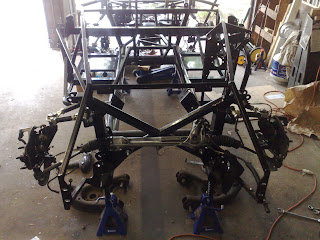My idea was simple and straight forward: push the heater further into the engine bay. After taking some measurements it was clear that about 2 inches could be had. The next step would be to prototype the solution to see how it would look like in real life. I used a cardboard box to design my modified firewall.
Here I outlined the firewall and placed the stencil for heater openings. The line at the bottom of the stencil is the location of 2x2 that holds the firewall. Thus, it's apparent that there is not much space below or above the heater.
My goal was to use the least amount of new sheet aluminum and reuse as much as possible. The motivation was simple: less cuts = less rivets = less work. Above you see that I literally split the new opening across at the center and bend it out. It gave me the desired depth for the heater and the leftovers made nice flaps for rivets.
This is the other piece that would make the extension complete. It would make up the back wall and the sides.
Here you can see the same stencil on the extension assembled. I had to provision some space on the sides and the top for the heater core to fit in. All in all it looked promising.
The next step is to try it out with the actual heater. Here, I have the heater core installed on the inside.
This is how it would look like from the other side. This is the passenger compartment side. The goal is to keep the side outlets as close as possible to the firewall (cardboard). I only have to provision some space for the ducting but that's really all I need there.
The next would be to see how it works on the car. So far looks promising.
Here's the other side. All systems go!
Some time later, with a bleeding finger, the parts were cut and bent. Notice this is not the design I had originally with cardboard. I actually missed some provisions with my prototype. The problem was mainly the missing flaps to join the bottom to the sides and the top to the sides. Here you see sides made separately with the top flap only. The back wall has the side flaps to join the sides. This part was done mainly to simplify my fabrication. What else you notice is the corner strips. I have came up with a clever approach to add rigidity to the firewall. The longer pieces would be running on the engine side along the firewall. They will join the sides and the firewall as well as overlap on the 2x2 vertically. The shorter pieces are going at the bottom corners and are joining the bottom to the side and too overlap the same 2x2 but horizontally. It would be more apparent once it all comes down as one assembly.
As with all of my aluminum parts, I sprayed the panels with rubberized coating to prevent oxidation.
The next step is to relax under a tree and rivet the pieces together. And voila!
Here's one more angle. You can see what I meant about those corner strips along the sides. Notice the two holes at the bottom. Those holes would be used to rivet the firewall to frame's 2x2 for rigidity.
Once in the firewall is in it's new permanent home, the heater was installed.
This is how it looks from the passenger compartment side. Here you can spot the shorter corner strips that lie on the top of the 2x2 and, again, add rigidity.
Mission is success!!! If I were to do it again: firstly, I'd rather not cut my finger with an angle grinder and, secondly, I'd add about a quarter inch of space to the sides and the top of the opening. The fit was a bit tight so the extra space would make the heater install step much smoother.


















































